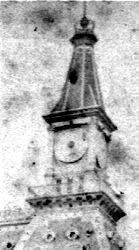Western Union Time Ball (original) (raw)
Designed and built in 1877 by George M. Phelps
How it worked:
At a distance the ball appeared to be a solid ball. It actually was made up of a dozen thin semicircles made of sheet copper, half of which were crescents. This allowed for minimal wind resistance when dropped.
The ball, when fully raised, was 315 feet above the street. It dropped 23 feet and was stopped slowly by six plungers that entered closed cylinders of the ball absorbing the shock.
Five minutes before noon, the officer in charge would hand crank a drum raising the ball nearly to the top. Two minutes before noon a signal was telegraphed to Washington indicating a ready status. The ball was then fully raised to the top of the iron flag staff. The crank was removed and the cord attached to the ball was held in place by a lever that engaged a ratchet wheel of the drum.
At exactly noon, the operator in Washington would close the circuit activating a electro-magnet located at the drum. This released the holding lever of the drum allowing the ball to drop. When the ball reached the bottom, a signal was sent automatically back to Washington indicating that the ball had dropped.
If for some reason the noon signal from Washington was not received, a red flag was raised and flown from 12:01 until 12:10.


Early photos showing the Time Ball
in its dropped position.

This was the view from Western Union's roof top during the 1880's. It gives an example of the Time Ball's visibility to the surrounding area during this era. The photo was taken from below the clock tower looking west towards the Hudson River over an area of New York that would later become the World Trade Center.
Return to the web site about Telegraph Inventor: George M. Phelps